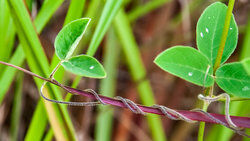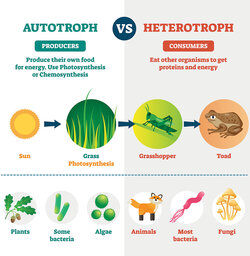
Have you ever thought about being able to make your own food? Not just cooking up a cheeseburger either! There are organisms that are able to use chemical reactions and light to make their own food. Curious to find out more? Explore the wonderful world of land and marine autotroph examples. Then, you can find out how an autotroph and heterotroph differ.
What Are Autotrophs?
You have to eat to get energy. But, did you know there are organisms that create their own food? These organisms are known as autotrophs, and they are a critical example of a biotic factor in an ecosystem. You might also hear them called producers.
Autotrophs use chemicals like carbon dioxide, the light from the sun and even water to create food. These fun little organisms can be found in the deep depths of the ocean or even in your own backyard.
Autotroph Types and Examples
When it comes to autotrophs, there are a lot of them out there. Marine autotroph examples might spring to mind, like plankton, but even the flower growing in your backyard is an example of an autotroph.
Typically, autotrophs are split into two different types:
- Photoautotrophs
- Chemoautotrophs
Learn what the difference is between these two types and check out several examples.
What Are Photoautotrophs?
Photoautotrophs are those green plants that you might water in your garden or they might even tangle you up when you go swimming. Photoautotrophs use photosynthesis to create their food. In other words, these plants and bacteria convert light, water and carbon dioxide into food. They are also the primary producers in their food chain.
An easy way to remember photoautotrophs use photosynthesis is to remember the prefix “photo” in both words, which means “light.” For examples of photoautotrophs, think of any green plant, like grass, moss, flowers, and trees.
Review a few unique examples that might not instantly spring to mind.
Algae
You know that green slime you try to avoid when swimming? Well, it is a photoautotroph. Algae can be found all over the world in oceans and lakes, just to name a few places. You might even find it in your aquarium.
Phytoplankton
Another marine autotroph example, phytoplankton are the plankton that use light to make their food. Unable to swim, they can be found drifting in large bodies of water. Like plants on dry land, phytoplankton are a primary food source for an array of aquatic animals.
Cyanobacteria
Not all photoautotrophs are plants; some are bacteria. Known as pond slime or blue-green algae, these unique marine autotroph examples live in the water making food from sunlight. Not only are these little organisms unique, but they also have a fossil record that goes back 3.5 billion years.
Chemoautotrophs
If you think about the parts that make up the word “chemoautotrophs,” you might be able to guess how they make their food. For chemoautotrophs, think “chemicals.” Chemoautotrophs use chemosynthesis to make their own food. What does that mean? They use chemical oxidation to turn substances like sulfur and hydrogen sulfide into food.
Since these autotrophs don’t need sunlight, they can live in some pretty awesome and scary places. For example, some chemoautotrophs live on the ocean vents on the seafloor. Could you imagine? Learn more about these amazing producers through examples.
Iron Bacteria
You might not realize it, but you probably have iron bacteria in your home. These bacteria are what create the rusty color in your toilet tank or on the lining of well-water pipes. If there is a lot of iron, they will be there. This is because iron bacteria oxidize iron for food. So, the next time that you have iron-related plumbing problems, you can probably thank iron bacteria.
Sulfur Bacteria
Per their name, sulfur bacteria convert sulfur into food. Not only can these bacteria be found on the ocean floor, but they may also be found in well water. Did you ever notice well water that smells of rotten eggs? Sulfur bacteria was probably present.
Autotroph and Heterotroph Differences
You can’t have a discussion about autotrophs without discussing how they differ from heterotrophs. While these two organisms might seem similar, they have one drastic difference. Heterotrophs can’t make their own food. This means, like you, heterotrophs need to eat other organisms to survive. Heterotrophs include carnivores (that eat meat), herbivores (that eat plants), and even omnivores (that eat both).

Autotroph vs Heterotroph
Autotrophs: the Food Creators
Autotrophs are typically at the beginning of a food web, because they can make their own food. They use both light synthesis and chemical synthesis. Now that you know about autotrophs, check out how they work in a food web.